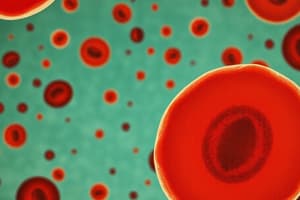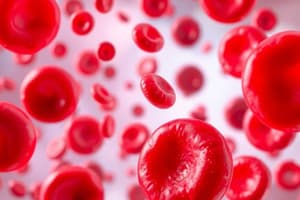Podcast
Questions and Answers
If a patient has elevated levels of bilirubin in their blood, which of the following processes is most likely impaired?
If a patient has elevated levels of bilirubin in their blood, which of the following processes is most likely impaired?
- Recycling of iron from heme groups to be reused in erythropoiesis.
- Production of intrinsic factor in the stomach.
- Synthesis of new hemoglobin molecules within red blood cells.
- Breakdown and excretion of aged or damaged red blood cells. (correct)
A patient is diagnosed with aplastic anemia. Which of the following would be the most likely course of treatment?
A patient is diagnosed with aplastic anemia. Which of the following would be the most likely course of treatment?
- Administration of erythropoietin to stimulate red blood cell production.
- Blood transfusion and bone marrow transplant (correct)
- Vitamin B12 injections to improve absorption.
- Iron supplements to increase heme production.
A patient has a thrombus in their leg. Which of the following medications would be most effective in preventing the thrombus from growing?
A patient has a thrombus in their leg. Which of the following medications would be most effective in preventing the thrombus from growing?
- A medication that enhances the release of serotonin from platelets.
- A medication that promotes platelet aggregation.
- A medication that increases the production of fibrinogen.
- A medication that inhibits the synthesis of prothrombin activator. (correct)
In a patient experiencing hypovolemic shock due to severe blood loss, what compensatory mechanism is least likely to occur in the initial response?
In a patient experiencing hypovolemic shock due to severe blood loss, what compensatory mechanism is least likely to occur in the initial response?
A researcher is investigating the movement of leukocytes out of blood vessels and into the interstitial space during an inflammatory response. Which process are they studying?
A researcher is investigating the movement of leukocytes out of blood vessels and into the interstitial space during an inflammatory response. Which process are they studying?
A patient's blood tests reveal a deficiency in intrinsic factor. Which of the following resulting conditions is most likely?
A patient's blood tests reveal a deficiency in intrinsic factor. Which of the following resulting conditions is most likely?
A patient with a chronic lung disease has persistently low blood oxygen levels. How will this most likely affect their red blood cell production?
A patient with a chronic lung disease has persistently low blood oxygen levels. How will this most likely affect their red blood cell production?
A researcher is analyzing a blood sample and observes that it separated into distinct layers after centrifugation. Which of the following best describes the composition of these layers from bottom to top?
A researcher is analyzing a blood sample and observes that it separated into distinct layers after centrifugation. Which of the following best describes the composition of these layers from bottom to top?
A patient's lab results show a prothrombin time significantly above the normal range. Which clotting mechanism is most likely impaired?
A patient's lab results show a prothrombin time significantly above the normal range. Which clotting mechanism is most likely impaired?
A patient presents with easy bruising and prolonged bleeding after minor cuts. A complete blood count reveals a platelet count of 80,000 per microliter. This condition is best described as:
A patient presents with easy bruising and prolonged bleeding after minor cuts. A complete blood count reveals a platelet count of 80,000 per microliter. This condition is best described as:
A person with type O blood is considered a universal donor. Why can type O blood be transfused into individuals with any ABO blood type?
A person with type O blood is considered a universal donor. Why can type O blood be transfused into individuals with any ABO blood type?
Erythroblastosis fetalis is a potentially life-threatening condition for a fetus. In which scenario is erythroblastosis fetalis most likely to occur?
Erythroblastosis fetalis is a potentially life-threatening condition for a fetus. In which scenario is erythroblastosis fetalis most likely to occur?
A phlebotomist is preparing to draw blood from a patient. To adhere to universal precautions, the phlebotomist must:
A phlebotomist is preparing to draw blood from a patient. To adhere to universal precautions, the phlebotomist must:
A patient's blood smear reveals a significant increase in abnormal, immature white blood cells (leukoblasts). Which condition is most consistent with these findings?
A patient's blood smear reveals a significant increase in abnormal, immature white blood cells (leukoblasts). Which condition is most consistent with these findings?
During a period of hypoxemia, the kidneys release erythropoietin (EPO). What is the primary physiological effect of increased EPO levels?
During a period of hypoxemia, the kidneys release erythropoietin (EPO). What is the primary physiological effect of increased EPO levels?
An athlete is suspected of blood doping to enhance performance. Which of the following blood parameters would most strongly suggest EPO abuse?
An athlete is suspected of blood doping to enhance performance. Which of the following blood parameters would most strongly suggest EPO abuse?
Flashcards
What is Hematocrit?
What is Hematocrit?
The percentage of blood volume composed of red blood cells.
What are the 'formed elements' of blood?
What are the 'formed elements' of blood?
Red blood cells (RBCs), white blood cells (WBCs), and platelets (cell fragments).
What are Platelets?
What are Platelets?
Small, disc-shaped cell fragments involved in blood clotting.
What are Lymphocytes?
What are Lymphocytes?
Signup and view all the flashcards
What is Heme?
What is Heme?
Signup and view all the flashcards
Which WBCs are Phagocytes?
Which WBCs are Phagocytes?
Signup and view all the flashcards
When does Cyanosis occur?
When does Cyanosis occur?
Signup and view all the flashcards
What hormone controls red blood cell production?
What hormone controls red blood cell production?
Signup and view all the flashcards
Prothrombin Time Test
Prothrombin Time Test
Signup and view all the flashcards
Thrombocytopenia
Thrombocytopenia
Signup and view all the flashcards
AB Blood Antigens
AB Blood Antigens
Signup and view all the flashcards
Blood Type Determination
Blood Type Determination
Signup and view all the flashcards
Erythroblastosis Fetalis
Erythroblastosis Fetalis
Signup and view all the flashcards
Rh-Negative
Rh-Negative
Signup and view all the flashcards
Universal Precautions
Universal Precautions
Signup and view all the flashcards
Leukemia
Leukemia
Signup and view all the flashcards
Study Notes
- Blood consists of 45% red blood cells.
- Formed elements in the blood include RBCs, WBCs, and platelets (cell fragments).
- Percent body fat influences blood volume.
- Red blood cells (erythrocytes) are the most abundant formed element.
- Mature red blood cells are biconcave and lack a nucleus.
- Lymphocytes and monocytes are agranulocytes.
- Platelets are thrombocytes, described as small, disc-shaped cell fragments.
- Lymphocytes' primary function is immune support against foreign substances.
- Vitamin B12 absorption is poor in the absence of intrinsic factor.
- Biliverdin and bilirubin are pigments from hemoglobin breakdown, specifically from the heme part.
- The breakdown order of hemoglobin is: Hemoglobin → heme → biliverdin → bilirubin.
- Iron is a component of heme.
- Platelets release serotonin.
- Neutrophils and monocytes function as phagocytes.
- Heparin prevents blood clotting by inhibiting prothrombin activator formation and thrombin's action on fibrinogen.
- Cyanosis occurs when deoxyhemoglobin levels are abnormally high.
- Sickle cell disease's underlying cause is a gene mutation.
- Aplastic anemia is caused by bone marrow destruction.
- Lymphocytes are essential for immunity.
- Diapedesis is defined as white blood cells moving through cell walls.
- Vascular spasm due to serotonin released by platelets stimulates blood vessels to spasm after an injury.
- Erythropoietin controls red blood cell production via a negative feedback mechanism.
- Creatinine is an example of a nonprotein nitrogenous substance (NPN) in plasma.
- Plasma electrolytes include sodium, potassium, calcium, magnesium, chloride, bicarbonate, and phosphate.
- Serum differs from plasma because it does not have fibrinogen.
- A thrombus is a blood clot that forms abnormally in the heart's blood vessel.
- Prothrombin time blood test evaluates the extrinsic clotting mechanism.
- Thrombocytopenia is defined as a below-normal platelet count.
- Type AB blood has A and B antigens on red blood cell surfaces.
- An individual’s blood type is determined by protein antigens on the surface of RBCs.
- Erythroblastosis fetalis may occur when a pregnant woman with Rh-negative blood is pregnant with an Rh+ fetus, typically in the first pregnancy.
- An Rh-negative person does not have the Rh antigen (D).
- Universal precautions include using PPE and hand washing with all patients.
- Leukemia involves overproduction of abnormal white blood cells (immature, leucoblast) and affects blood marrow.
- Plasma albumin helps maintain osmotic pressure.
- A basophil is the least abundant leukocyte in a blood sample.
- Iron is a component of the hemoglobin molecule.
- Enzyme streptokinase and tPA (tissue plasminogen activator) function to dissolve blood clots.
- Cyanosis is caused by an increased blood concentration of deoxygenated hemoglobin (deoxyhemoglobin).
- Hypoxemia stimulates the release of erythropoietin (EPO).
- Platelets are cell fragments released by megakaryocytes.
- Blood flow decreases and becomes sluggish when blood is too viscous.
- Normal blood pH is 7.35-7.45.
- A normal hematocrit value is 45%.
- Hematocrit, RBC count, and hemoglobin concentration values are typically higher in males than females.
- A hematocrit measures the percentage of blood volume occupied by red blood cells.
- A normal white blood cell count is 4,500 per microliter.
- The correct sequence for red blood cell differentiation is: Hemocytoblast → myeloid stem cell → erythroblast → reticulocyte → erythrocyte.
- Pernicious anemia results from a lack of vitamin B12.
- Hemolytic anemia involves red blood cells breaking down faster than they can form.
- Elite athletes might abuse erythropoietin (EPO) for enhanced endurance and performance due to more oxygen to the muscles, causing more ATP.
- A pulmonary embolism is defined as a clot on pulmonary arteries.
- A person with type AB blood can receive all blood types.
- Polycythemia is an increased number of RBCs.
- Leukocytosis is elevated white blood cells.
Studying That Suits You
Use AI to generate personalized quizzes and flashcards to suit your learning preferences.




